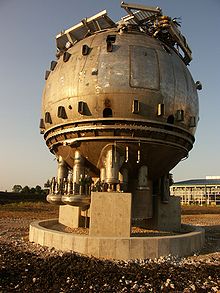
Back غرفة فقاقيع Arabic Пузырковая камера BE Мехурчеста камера Bulgarian বাবল চেম্বার Bengali/Bangla Cambra de bombolles Catalan Bublinková komora Czech Blasenkammer German Bobelkamero EO Cámara de burbujas Spanish Mullikamber ET


A bubble chamber is a vessel filled with a superheated transparent liquid (most often liquid hydrogen) used to detect electrically charged particles moving through it. It was invented in 1952 by Donald A. Glaser,[1] for which he was awarded the 1960 Nobel Prize in Physics.[2] Supposedly, Glaser was inspired by the bubbles in a glass of beer; however, in a 2006 talk, he refuted this story, although saying that while beer was not the inspiration for the bubble chamber, he did experiments using beer to fill early prototypes.[3]
While bubble chambers were extensively used in the past, they have now mostly been supplanted by wire chambers, spark chambers, drift chambers, and silicon detectors. Notable bubble chambers include the Big European Bubble Chamber (BEBC) and Gargamelle.
- ^ Donald A. Glaser (1952). "Some Effects of Ionizing Radiation on the Formation of Bubbles in Liquids". Physical Review. 87 (4): 665. Bibcode:1952PhRv...87..665G. doi:10.1103/PhysRev.87.665.
- ^ "The Nobel Prize in Physics 1960". The Nobel Foundation. Retrieved 2009-10-03.
- ^ Anne Pinckard (21 July 2006). "Front Seat to History: Summer Lecture Series Kicks Off – Invention and History of the Bubble Chamber". Berkeley Lab View Archive. Lawrence Berkeley National Laboratory. Archived from the original on 2017-12-24. Retrieved 2009-10-03.